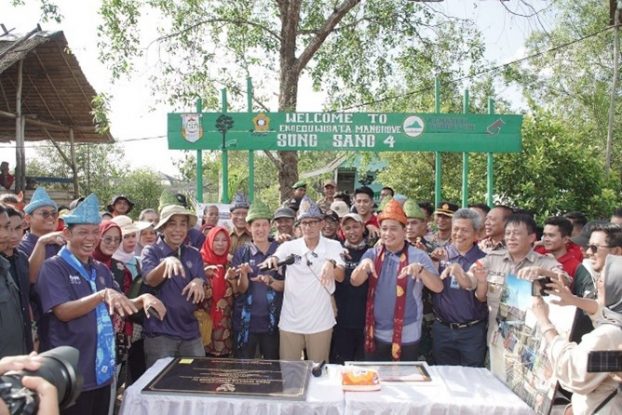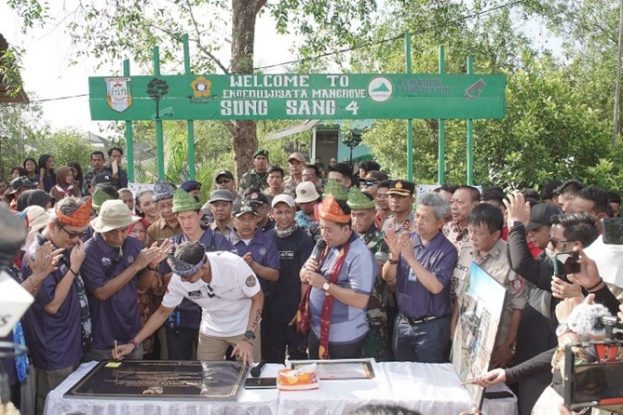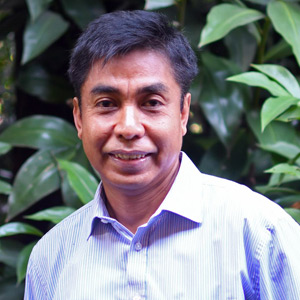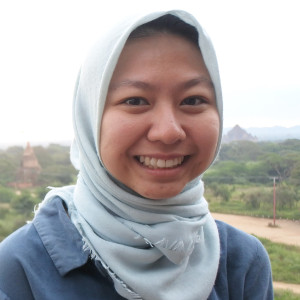We want you to share Forests News content, which is licensed under Creative Commons Attribution-NonCommercial-ShareAlike 4.0 International (CC BY-NC-SA 4.0). This means you are free to redistribute our material for non-commercial purposes. All we ask is that you give Forests News appropriate credit and link to the original Forests News content, indicate if changes were made, and distribute your contributions under the same Creative Commons license. You must notify Forests News if you repost, reprint or reuse our materials by contacting forestsnews@cifor-icraf.org.
Sungsang IV Village is a coastal community in South Sumatra. Most of its Indigenous Malayu residents are fisherpeople who live in distinctive wooden huts – many of which are perched on long poles above the tides.
Their settlement sits alongside a protected stretch of mangroves, lowland forest, and peatlands called the Sembilang National Park, which represents a rare remaining wetland ecosystem in the region and is a UNESCO Biosphere Reserve. At the heart of Sungsang IV, villagers process and sell a range of exotic seafood dishes that are unique to the area, such as pempek udang [savoury fishcakes] made from shrimp.
Given its cultural and natural riches, the village was earmarked as a potential tourism destination by the local Banyuasin Regency, and a development program was launched to this end in December 2020.


 Minister of Indonesian Tourism Board, Sandiaga Uno avisited location of Sungsang Mangrove Restoration and Ecotourism in Banyuasin Region, South Sumatera
Minister of Indonesian Tourism Board, Sandiaga Uno avisited location of Sungsang Mangrove Restoration and Ecotourism in Banyuasin Region, South Sumatera 
Tourism activities in Sungsang IV – including mangrove ecotourism – will contribute to positive community development in the area.
Sandiaga Uno, Minister of Indonesian Tourism Board
Award-winning nature and culture
In November of 2022, the Government of South Sumatra awarded Sungsang IV the title of ‘Best Tourism Village’ in the province. It was then submitted to the Indonesian Tourism Village Award Program (ADWI – Anugerah Desa Wisata Indonesia), and selected as one of the 75 best tourism villages in the country in March 2023.
On the 13th of May 2023, the Minister of Tourism and Creative Economy, Sandiaga Uno, visited the village to deliver the award to the community. He was welcomed with a traditional art ceremony, and then had the opportunity to sample local cuisine and peruse handicrafts made by villagers.
He also visited several tourist attractions, including the community-based mangrove nursery described in more detail below, where he contributed to the mangrove restoration program by planting seedlings alongside provincial, regency, and local leaders. Uno expressed his hope that tourism activities in Sungsang IV – including mangrove ecotourism – will contribute to positive community development in the area.

Mangrove ecosystem services has economy potential, our research is to look on potential business-model from mangrove ecosystem that can provide income for community.
Herry Purnomo, Scientist, CIFOR-ICRAF
Boosting natural assets with mangrove restoration
As Uno and others highlighted during the visit, a big part of Sungsang IV’s tourism potential relies on its natural resources, including its mangrove forests. However, some of these forests are significantly degraded.
In that context, since 2021 the Centre for International Forestry Research and World Agroforestry (CIFOR-ICRAF), and local partners Sriwijaya University and the South Sumatra Watershed Forum (Forum DAS Sumsel), have been implementing a participatory action research project in the village to develop ecologically-feasible, locally-appropriate, and community-based business models for mangrove restoration. The project runs for four years and is supported by the Singapore-based Temasek Foundation.
During the research process, the community – alongside key stakeholders and government leaders at regency and provincial levels – agreed that to strengthen local tourism potential, mangroves must be billed as one of the main attractions. To that end, the community and research team established a mangrove nursery facility, which to date has produced more than 50,000 seedlings from seven different species – including the native Kandelia candel, which can only be found in certain parts of Indonesia.
The community is progressing mangrove restoration activities in selected ‘action arenas’ within the village, in accordance with its aims of coastal ecosystem enhancement and improved mangrove conditions for ecotourism. The arenas also serve as a ‘natural laboratory’ for visiting university students. CIFOR-ICRAF and its partners hope that the action research will strengthen ecotourism implementation and overall tourism potential to generate ecological, economic, and social benefits for Sungsang IV’s community.
Story: Sonya Dyah | Videos: Aris Sanjaya | Web design: Gusdiyanto | Coordinator : Budhy Kristanty
We want you to share Forests News content, which is licensed under Creative Commons Attribution-NonCommercial-ShareAlike 4.0 International (CC BY-NC-SA 4.0). This means you are free to redistribute our material for non-commercial purposes. All we ask is that you give Forests News appropriate credit and link to the original Forests News content, indicate if changes were made, and distribute your contributions under the same Creative Commons license. You must notify Forests News if you repost, reprint or reuse our materials by contacting forestsnews@cifor-icraf.org.



